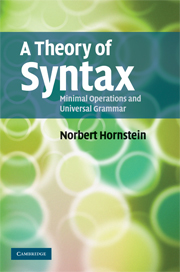Book contents
- Frontmatter
- Contents
- Preface
- 1 Minimalism and Darwin's Problem
- 2 Deriving c-command
- 3 Labels, recursion and movement
- 4 Some thoughts on adjunction
- 5 The emerging picture: Basic operations, FL and the Minimalist Program
- 6 Stop AGREEing! Keep Moving!
- 7 Conclusions, consequences and more questions
- References
- Index
2 - Deriving c-command
Published online by Cambridge University Press: 01 July 2009
- Frontmatter
- Contents
- Preface
- 1 Minimalism and Darwin's Problem
- 2 Deriving c-command
- 3 Labels, recursion and movement
- 4 Some thoughts on adjunction
- 5 The emerging picture: Basic operations, FL and the Minimalist Program
- 6 Stop AGREEing! Keep Moving!
- 7 Conclusions, consequences and more questions
- References
- Index
Summary
Introduction: The sources of c-command
Of the core syntactic relations in UG, none is more gregarious than c-command. It plays a key role in at least three different domains: binding, linearization and movement. Consider how.
All three principles of the binding theory exploit c-command in their definition of binding, binders being expressions that both c-command and are co-indexed with their dependents. More concretely, anaphors must be locally bound by their antecedents, pronouns cannot be locally bound by their antecedents, and R-expressions cannot be bound at all. In addition, pronouns interpreted as variables (“bound pronouns”) are (typically) c-commanded by their antecedents.
Similarly, most (if not all) versions of the Linear Correspondence Axiom (LCA) are defined in terms of asymmetric c-command: thus α precedes β just in case α asymmetrically c-commands β.
Lastly, movement also crucially invokes c-command. For example, ECP-based accounts define antecedent government in terms of binding and the latter, as noted, is defined in terms of c-command. In addition, chains are defined in terms of c-command (links in a chain c-command one another) as is a central well-formedness condition on movement and/or chains, the minimality condition. Consider the latter, as it will be a focus of what follows.
Minimality restricts operations in the configurations in (1).
(1) Minimality: A movement operation cannot involve X1 and X3 over an X2 which is identical to X3:
… X1 …. X2 …. X3 ….
A key feature of the above restriction is that it only applies when the relevant Xs are in a c-command configuration; in particular, X2 blocks X3 just in case it c-commands X3.
- Type
- Chapter
- Information
- A Theory of SyntaxMinimal Operations and Universal Grammar, pp. 17 - 52Publisher: Cambridge University PressPrint publication year: 2008



